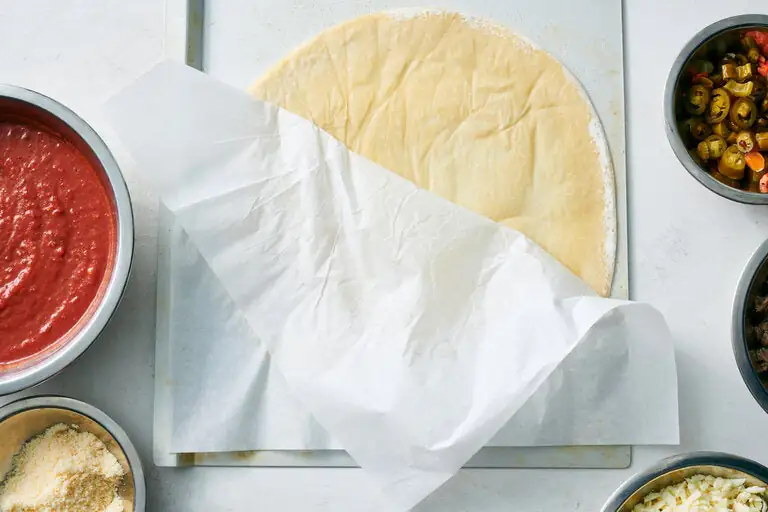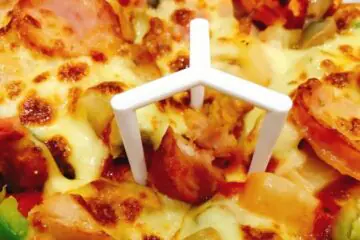For a 12-inch pizza, you will need approximately 1/2 to 3/4 cup of pizza sauce.

Credit: smittenkitchen.com
Understanding The Importance Of Pizza Sauce Quantity
When creating the perfect Pizza, every ingredient plays a crucial role in achieving that delicious, mouthwatering flavor. However, one component that often gets overlooked is the pizza sauce. Many pizza enthusiasts mistakenly assume that the amount of sauce used is a mere detail, but understanding the importance of pizza sauce quantity is critical to creating a genuinely exceptional pizza.
The Crucial Role Of Pizza Sauce In Achieving A Delicious Pizza
Before we delve into the right amount of sauce for a 12-inch pizza, let’s first establish the critical role that pizza sauce plays. The sauce is the flavorful foundation upon which all other toppings are built. It not only adds moisture to the Pizza but also brings out the flavors of the cheese, meats, and veggies that complement it. The right amount of sauce ensures that the Pizza is not overwhelmingly dry or excessively saucy, striking the perfect balance in every bite.
Balancing The Sauce With Other Toppings For A Harmonious Flavor
Like a symphony orchestra, each ingredient on a pizza has its role to play. Balancing the sauce with other toppings is essential for achieving a harmonious blend of flavors. More sauce can overpower the taste of other ingredients, leading to a smooth and balanced pizza. On the other hand, too little spice can result in a dry and lackluster experience. The secret to creating a pizza that tantalizes your taste buds with every bite is the proper sauce-to-topping ratio.
The Impact Of Too Much Or Too Little Sauce On The Overall Taste
Now, let’s explore the impact of using too much or too little sauce on the overall taste of your Pizza. When using an excess of spice, the Pizza becomes overly soggy and can lead to a lack of cohesion between the crust, cheese, and toppings. This can result in a messy eating experience and flavors that don’t blend harmoniously. On the other hand, if too little sauce is used, the Pizza can end up dry and lacking in flavor, dulling the overall enjoyment.
Therefore, finding the right balance is essential to creating a delicious pizza. It all starts with understanding the importance of pizza sauce quantity.
Factors To Consider When Determining Sauce Quantity
When it comes to determining the right amount of sauce for a 12-inch pizza, the size of the Pizza itself plays a crucial role. As the diameter of the Pizza increases, so does the amount of sauce needed to cover the crust evenly. A giant pizza requires a generous amount of spice to ensure every bite is flavorful.
Additionally, the thickness of the crust is another factor to consider. A thin-crust pizza may require less sauce than a deep dish or pan pizza. The thickness of the crust affects the sauce-to-crust ratio, and it’s essential to strike the right balance to achieve the perfect pizza experience.
The consistency of pizza sauce also plays a significant role in determining the quantity needed. Different sauce consistency types are available, including thick, thin, and chunky. The thick sauce tends to be denser and may require less to cover the Pizza adequately.
On the other hand, thin sauce spreads more quickly, so a slightly more significant amount may be needed to ensure even coverage. Chunky sauce, with small chunks of tomatoes or other ingredients, may require even more spice to compensate for the gaps between the toppings.
—
Personal preference and desired sauce-to-topping ratio also play an essential role in determining the quantity of sauce to use on a 12-inch pizza. Some individuals prefer a saucier pizza with a thicker layer of sauce, while others may opt for a lighter coating that allows the flavors of the toppings to shine through.
A general rule of thumb is to use approximately 1/4 to 1/3 cup of sauce for a 12-inch pizza, but this can vary depending on personal preference and desired taste. Experimenting with different amounts of spice is the key to finding the perfect balance that satisfies your taste buds.
In conclusion, when determining the sauce quantity for a 12-inch pizza, factors such as the size of the Pizza, crust thickness, type of sauce consistency, and personal preference all come into play. It is essential to find the right balance that ensures every bite is delicious and satisfying.
Guidelines For Calculating The Ideal Sauce Amount
When making the perfect 12-inch Pizza, getting the right amount of sauce can make all the difference. Too little sauce and your Pizza might taste dry, while too much sauce can make it soggy and overpower the other flavors. This guide will provide some handy guidelines to help you calculate the ideal amount of pizza sauce for your 12-inch Pizza.
Estimating The Right Amount Based On Pizza Size And Crust Thickness
To ensure the perfect balance of flavors, it’s important to consider the size of your Pizza and the thickness of the crust when calculating the amount of sauce to use. As a general rule of thumb, you can follow the table below:
| Pizza Size | Crust Thickness | Ideal Sauce Amount |
|---|---|---|
| 12-inch Pizza | Thin crust | 1/4 to 1/3 cup |
| 12-inch Pizza | Thick crust | 1/3 to 1/2 cup |
Remember that these are just estimates, and you can adjust the sauce amount based on your preference. If you prefer a saucier pizza, you can increase the amount accordingly, or if you enjoy a drier pizza, you can reduce it slightly. The goal is to have enough sauce to enhance the flavors without overwhelming the other toppings.
Tips For Evenly Spreading The Sauce On The Pizza Dough
Once you have determined the ideal amount of sauce, it’s important to spread it on the pizza dough evenly. This ensures that every bite is filled with delicious flavor. Here are some tips to help you achieve even distribution:
- Start by pouring the sauce in the center of the dough.
- Using a spoon or ladle, gradually spread the sauce in a spiral motion toward the edges of the Pizza.
- Avoid applying the dressing too close to the border to prevent it from spilling during baking.
- Pay attention to the thickness of the sauce layer, aiming for an even coating.
- Refrain from pressing down on the sauce too hard, which can cause the dough to become soggy.
By following these tips, you can ensure that the sauce is evenly distributed across the Pizza, resulting in a delicious and well-balanced flavor profile.
Adjusting The Sauce Quantity For Different Sauce Consistencies
It’s important to note that different pizza sauce consistencies may require adjustments in the quantity used. Thick, chunky sauces will naturally require more sauce for an even coating, while thinner sauces may need less. Here are some guidelines:
- If your sauce is thicker, slightly increase it to ensure adequate coverage.
- Reduce the quantity a bit for thinner sauces to avoid a watery pizza.
- Taste and adjust the seasoning before spreading it on the pizza dough if you’re using a homemade sauce.
Ultimately, achieving the ideal sauce for your 12-inch Pizza comes down to personal preference. Feel free to experiment and adjust the quantities to suit your taste. With these guidelines in mind, you’ll be well on your way to creating a mouthwatering pizza that everyone will enjoy!
Troubleshooting: Dealing With Sauce Quantity Issues
When making the perfect Pizza, getting the sauce quantity right is a delicate balance. More sauce can result in a soggy crust and overpowering flavors, while more sauce can leave your Pizza tasting dry and exciting. In this troubleshooting guide, we’ll address common sauce quantity issues and provide tips on how to fix them.
Signs Of Too Much Sauce And How To Fix It
If you’ve ever taken a bite of Pizza and found yourself with a mouthful of sauce, you know the struggle of dealing with too much sauce. Here are some signs that your Pizza has too much sauce:
- The sauce is pooling in the center of the Pizza
- The crust is soggy and difficult to hold
- The sauce overpowers the flavors of the toppings
To fix this issue, you can try the following strategies:
- Use a spoon to distribute the sauce evenly: Spread the sauce from the center of the Pizza to the edges, making sure not to leave any empty spots. This will help prevent pooling in the center.
- Remove excess sauce with a paper towel: Gently blot the surface of the Pizza with a paper towel to soak up any extra sauce. Be careful not to remove too much sauce, as this can result in a dry pizza.
- Opt for a thicker crust: A thicker crust can better handle a generous amount of sauce without becoming overly soggy. Consider using a thicker crust if you prefer a saucier pizza.
Strategies For Dealing With Too Little Sauce
If your Pizza has too little sauce, you may notice the following signs:
- The toppings are dry and lack moisture
- The crust lacks flavor
- The overall taste is bland and unappealing
Here are a few strategies to address this issue:
- Add sauce to the toppings: If your Pizza lacks seasoning, you can compensate by spooning additional sauce directly onto the toppings. This will help infuse the flavors throughout the Pizza.
- Precook the crust with sauce: Before adding the toppings, you can precook the crust with a thin layer of sauce. This will help ensure that the crust absorbs the sauce and remains flavorful.
- Experiment with different types of sauce: If you consistently find that your pizzas have too little spice, try experimenting with different kinds of sauce or adjusting the recipe to include more sauce. Different sauces vary in viscosity, so finding one that suits your preferences can make a big difference.
Techniques To Prevent Sauce From Sliding Off The Pizza During Baking
One frustrating issue that pizza enthusiasts often face is the sauce that slides off the Pizza during baking. To prevent this from happening, consider the following techniques:
- Thicken the sauce: If your sauce is too thin, it’s more likely to slide off the Pizza. Add a thickening agent, such as tomato paste, to give the sauce more body and stability.
- Use less liquid toppings: Wet toppings like sliced tomatoes or fresh mozzarella can contribute to sauce runoff. Consider using less liquid-heavy toppings or patting them dry before placing them on the Pizza.
- Precooked the sauce: Precooking the spice can help reduce its moisture content, making it less prone to sliding off the Pizza. Simmering the sauce for a few minutes before using it as a topping can be beneficial.
With these troubleshooting tips in mind, you’ll be well-equipped to handle any sauce quantity issues and create delicious pizzas every time!
Expert Tips For Mastering The Perfect Sauce Quantity
When making a delicious pizza, one of the critical factors that can make or break the overall flavor is the amount of sauce used. Finding the perfect sauce quantity is crucial for achieving a well-balanced and flavorful pizza. This article will provide expert tips to help you master the art of determining the ideal amount of pizza sauce for a 12-inch pizza.
Using A Sauce Ladle Or Measuring Cup For Consistent Application
To ensure consistent and even sauce distribution, it is recommended to use a sauce ladle or a measuring cup when applying the dressing to the pizza dough. These tools help you gauge and control the amount of sauce being applied, ensuring that each Pizza receives the same quantity of sauce. This is especially important as it helps maintain the balance between the sauce and other toppings, preventing the Pizza from becoming too saucy or dry.
Experimenting With Different Sauce-to-topping Combinations
Creating the perfect pizza sauce quantity is more than measuring and applying a specific amount. It also involves experimenting with different sauce-to-topping combinations to find your preference’s taste profile. Some people prefer a generous sauce that complements the toppings, while others prefer a lighter touch, allowing the flavors to shine through. By trying out various combinations, you can discover the sauce quantity that best enhances the overall taste of your Pizza.
Adapting The Sauce Quantity Based On Crust Types And Baking Methods
The ideal sauce quantity can also vary based on the type of crust you are using and the baking method employed. A lighter sauce is generally recommended for thin-crust pizzas, as too much sauce can make the crust soggy. On the other hand, thick-crust pizzas can handle a bit more spice without compromising the texture. If you’re making a stuffed crust pizza, consider reducing the sauce quantity slightly to prevent the sauce from leaking out during baking.
Additionally, the sauce quantity can be influenced by the baking method. If you are baking your Pizza in a traditional home oven, it is advisable to use a slightly lesser amount of sauce, as the longer baking time can intensify the flavors and make it more pronounced. However, if you use a high-temperature wood-fired oven, you may want to increase the sauce quantity to prevent the Pizza from drying out in the intense heat.
Summary
Mastering the perfect sauce quantity for a 12-inch pizza requires a combination of careful measurement, experimentation, and adaptation based on crust types and baking methods. By using a sauce spoon or measuring cup for consistent application, exploring different sauce-to-topping combinations, and adjusting the sauce quantity to suit your desired crust and baking style, you can create a pizza that is bursting with flavor and perfectly balanced.
Conclusion
Finding the proper pizza sauce can make or break your 12-inch pizza experience. By following the simple guidelines in this blog post, you can ensure a perfect balance of flavors for your Pizza. Whether you prefer a saucy or a lightly coated pizza, experimenting and adjusting the amount of sauce will help you achieve your desired taste.
Remember to consider personal preferences and toppings when determining the ideal amount of sauce. Enjoy your homemade Pizza with confidence, knowing you’ve achieved the perfect sauce-to-crust ratio.

As the author of the “Ultimate Pizza Guide: Recipes, Tips & Secrets Revealed,” I’m dedicated to sharing my love for pizza and empowering others to create delicious homemade pizzas with ease. Join me on a journey to uncover the secrets to perfecting your pizza game!



